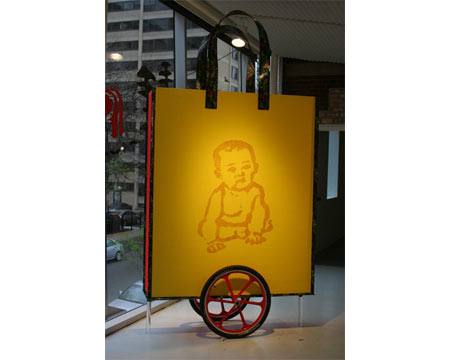
Before Los Angeles, Chicago was the hub where manufactured goods going in one direction crossed paths with raw materials moving in the other. It was there in the Windy City that Fang Ling-An taught Chinese while pursuing her art degree, and also where she first came across the phenomenon of Chinese children who were adopted by primarily non-Asian parents. For the sculptural centerpiece in her first solo show in Los Angeles, Ling-An amalgamates the materials of our transcontinental commerce. A super-sized shopping bag on wheels, complete with a silk-screened Buddha-like baby, conjures up the children that cross the Pacific in tow with eager American parents, along with the Wal-Mart destined cribs and car seats that will contain them.
As visually impactful as Ling-An’s work is, it doesn’t come across as preachy or excessively nationalistic. Having been raised by Chinese parents forced to live in Taiwan as translocated exiles, the artist herself is the hybrid product of well-intentioned elders who attempted to re-infuse her with bits of the culture from which they were excluded.
In a related narrative vein are smaller sculptures patterned after a baby’s camisole. Crafted of high-luster industrial materials, they evoke thoughts ranging from California finish-fetish artists to Jeff Koons.
Back in the days before amniocentesis and ultra-sound told you in advance, these ambulators were crafted with a girl-centric fabric on one side, and a boy’s color or print on the other. This duality becomes a metaphor for Ling-An’s skills and experience: Steeped in the traditions of China while versed in the conversations of contemporary Western art.
In the most recent work here, additional dualisms both complicate and deepen the reading of the work. Traditional craft techniques and materials make their mark, like embroidery with silk and gold threads — along with silk-screens and tarpaulins printed in camouflage. These embroidered works are presented both ways: in some their finished surface to the viewer; in many others the expected “front” is facing the wall, presenting the viewer with an abstracted verso of knots and tangles of string. Like her ambidextrous note-taking and sketching methodology — writing Chinese characters with her left hand and English with her right — Ling-An embroiders these later works from both sides, delineating forms from one side, then abstracting them from the other. The confusion draws in the eye, and one can’t help interpolating figures. In “Mama Maya,” a Judith-like character appears, dagger held up in one hand and the head of Holofernes in the other. Ling-An remembers similar stories of daemon head-toting females from her travels in India and folktales from her childhood, and she weaves the characters together on her canvases.
It is easier to describe what Ling-An’s work is not: it isn’t traditional craft nor is it a straightforward presentation of Western form and iconography. Like the artist herself, the work in “Everything Stitching Together Simultaneously” is a hybrid of lived experience and cultures — a hub of commerce and humanity.
Published courtesy of ArtSceneCal ©2010
